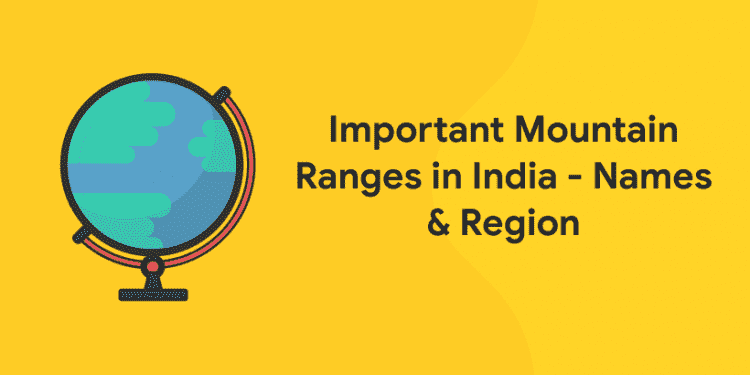The world has many prominent mountain ranges that are very well known but do we know about the mountain ranges in India? If the exam is to be written in India the question will less likely be about the Andes and the Alps and more about the Indian mountain ranges like the Himalayas. Don’t worry, we are here to help with that.
Mountain Ranges
1. Great Himalaya Range
In India, the Himalaya mountain range is geographically split into the Great Himalaya, Middle Himalaya and Outer Himalaya ranges. The Great Himalaya is the highest zone, with perpetually snow-covered peaks rising more than 22,000 feet above sea level. It stretches for over 1,200 miles along India’s northern border, all the way from Jammu and Kashmir in the West (where it’s bounded by the Indus River) to Arunachal Pradesh in the East. The section in Sikkim has the loftiest peaks, with Mount Kanchenjunga being the third highest peak in the world at 28,169 feet above sea level. It’s shared with Nepal though.
2. Middle Himalaya Range
The fertile and predominantly forest-covered Middle Himalaya mountain range runs parallel to the Great Himalaya on its southern side. Its peaks are much more accessible, with elevations of about 5,000 to 20,000 feet above sea level. Most of India’s popular hill stations are located in the Middle Himalaya, in the states of Himachal Pradesh and Uttarakhand. The Great Himalayan National Park (one of India’s little-known UNESCO World Heritage sites), in the Kullu district of Himachal Pradesh, is part of the range as are popular adventure destinations Auli and the Valley of Flowers National Park in Uttarakhand. The Middle Himalayas also cover the Kashmir Valley in Jammu and Kashmir, Darjeeling in West Bengal, and Gangtok in Sikkim.
3. Outer Himalaya Shivalik Range
The Outer Himalayas, also known as the Shivalik Range, is regarded as the Himalayan foothills. It separates the mountains from the plains and consists of valleys and hills that rise no more than about 5,000 feet above sea level. A large part of the range is located in Himachal Pradesh, up to the Beas River. It also encompasses Jammu, some of Punjab and Chandigarh, Haridwar and Rishikesh in Uttarakhand, and Kalimpong in West Bengal.
4. Trans-Himalaya Karakoram Range
The Trans-Himalaya, to the north of the Great Himalaya in the Union Territory of Ladakh, is India’s most isolated and remote mountain range. It’s made up of the Karakoram, Zanskar and Ladakh ranges. The craggy Karakoram Range is bounded by the Nubra Valley to the south and extends north into the Gilgit-Baltistan region of Pakistan. This formidable, impenetrable mountain range is sometimes referred to as “the roof of the world.” It has eight peaks over 24,600 feet in height and its elevation rarely falls below 18,045 feet. The tallest peak, K2, is located in disputed territory that’s currently controlled by Pakistan. At 28,251 feet above sea level, it’s the second-highest mountain in the world.
5. Trans-Himalaya Ladakh Range
The Ladakh Range lies to the south of the Karakoram Range, between the Nubra Valley and Leh. It runs parallel to the Indus River and extends to India’s border with Tibet. The landscape is characterized by granite rocks and sparse vegetation. The peaks in this range are about 16,400 to 19,700 feet above sea level. Instead of having any notable peaks, the Ladakh Range is better known for its spectacular high-altitude mountain passes. The most famous of these is Khardung La, which is often incorrectly said to be the highest drivable road in the world.
6. Trans-Himalaya Zanskar Range
South of the Ladakh Range, on the other side of the Indus River, the Zanskar Range separates the Ladakh region from the Zanskar region of Jammu and Kashmir. Its peaks are higher than that of the Ladakh Range, with many rising more than 19,500 feet above sea level. The tallest are the twin peaks of Nun, at 23,409 feet, and Kun at 23,218 feet. It’s possible to climb them, although the trek is challenging. Adjacent to these peaks, in the Shafat Glacier, Pinnacle Peak is the third highest mountain in the range at 22,736 feet above sea level.
7. Purvanchal Range
The Purvanchal Range lies south of the Brahmaputra (Dihang) River in Arunachal Pradesh and forms the boundary between India and Myanmar. It extends along the Northeast Indian states and has a relatively low elevation that decreases towards the south. The average height of peaks in this range is about 9,845 feet above sea level.
8. Aravalli Range
The 500-mile-long Aravalli Range (meaning “line of peaks”) runs from Champaner and Palanpur in eastern Gujarat to the outskirts of Delhi. About 80 per cent of it is situated in Rajasthan, where it borders the Thar desert and provides protection from the extreme desert climate. The highest peak is Guru Shikhar at Mount Abu, near the Gujarat border, with an elevation of 5,650 feet above sea level. However, most of the hills are concentrated in the area around Udaipur. Mewar rulers used this to their advantage by constructing immense forts, such as Chittorgarh and Kumbhalgarh, in strategic places.
9. Vindhya Range
The Vindhya Range runs across central India on the northern side of the Narmada River in Madhya Pradesh. It extends more than 675 miles from Jobat in Gujarat to Sasaram in Bihar. Technically, it’s not a single mountain range but chains of hills, ridges and plateaus. This is particularly so after it divides and branches east of Madhya Pradesh’s Malwa region. The general elevation of the Vindhya Range is around 980-2,100 feet above sea level, with peaks rarely going over 2,300 feet.
10. Satpura Range
On the southern side of the Narmada River in Madhya Pradesh, the Satpura Range runs parallel to the Vindhya Range in between the Narmada and Tapti rivers. It extends for about 560 miles from the Rajpipla Hills in Gujarat to the Maikala Hills in Chhattisgarh (where it meets the Vindhya Range at Amarkantak). The Satpura Range is higher than the Vindhya Range, with peaks reaching over 4,000 feet in the heavily forested Mahadeo Hills at Pachmarhi.
11. Western Ghats
The lengthy Western Ghats runs for approximately 5,250 miles along the western side of India, separating the coast from the Deccan plains. It extends from near the Satpura Range in Gujarat down through Maharashtra, Goa, Karnataka, Kerala and Tamil Nadu to end at the southernmost tip of India near Kanyakumari. The Western Ghats is made up of multiple mountain ranges, with more than 70 peaks varying in height from 1,713 feet to 8,842 feet above sea level. Almost a third of them are above 6,561 feet, with most of these being in Kerala.
12. Eastern Ghats
Similar to the Western Ghats, the lesser-known Eastern Ghats separates the coast from the plains on the eastern side of India. It runs through Odisha, Andhra Pradesh and Tamil Nadu (where it meets the Western Ghats at the Nilgiri mountains). The Eastern Ghats is flatter than the Western Ghats, and its hills have been divided into several parts by the major rivers in southern India (the Godavari, Mahanadi, Krishna, and Kaveri). It still has a few peaks over 3,280 feet above sea level though, mainly in the Maliya Range in Odisha and Madugula Konda Range in Andhra Pradesh.
Well, surely these 12 major mountain ranges will be helpful for your SSC exams, CAPF exams and others that include GK in their syllabi. Keep learning and have a nice day! 🙂












